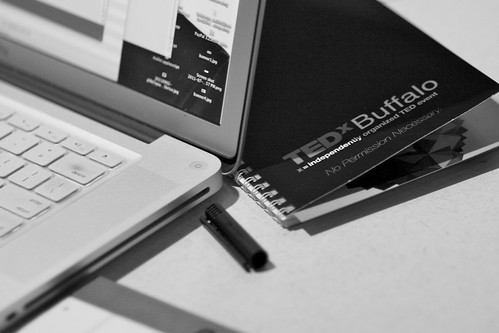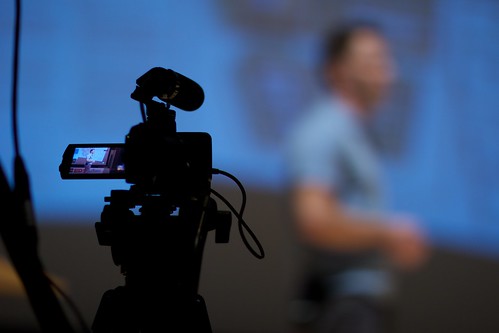This post was originally published at the TEDx blog/Tumblr. It was written quickly, and at least one fellow English major shook his head in dismay after seeing the first draft. But it was written very soon after the event, and I’m hoping it provides some lessons to learn from, and maybe some nostalgia on some distant day.

TEDxBuffalo took 17 months to launch, but there were really only five months of solid planning. That is, there was a year-long initial attempt that fell apart on very short notice, followed by a rather quick revival. But our first actual event, put on by about a dozen core volunteers and many more contributors, made everyone hungry to do it again.
Buffalo, NY is a rust belt city filled with chances to start over, build something new, and shake things up. It’s also a place where the status quo is palpable: waterfront projects have been debated endlessly, preservation and development movements constantly butt heads, and even a nascent surge in gourmet food trucks has met with thick red tape. That’s why our first TEDxBuffalo event had a theme of “No Permission Necessary.” We invited speakers and performers who encouraged, and had often started, projects that don’t require a grant, a board of directors, or even a whole lot of money&emdash;just a good idea.
It would have been easy to find speakers to talk about job creation, preservation, waterfront development, and regional coordination. Those are Buffalo’s go-to topics, and each has its own events and organizations. We strove instead to tell untold stories and to find people whose ideas played well together. Our speakers came mostly from our volunteers’ own research and backgrounds. To select our dozen speakers, and a small group simply scored them, on a 1-to-5 basis, on how their interests and obsessions fit: with our theme, as a unique topic, and as an idea worth spreading. Our volunteers also knew a few performers who did interesting things: built their own techno-acoustic instruments, for example, or engaged in “guerilla improv.”
Because TEDx talks are limited to 18 minutes, and because TEDx events are required to screen TED Talks as 25% of their event content, we broke the whole day into 20-minute blocks. That meant each talk, video, or performance had about 2 minutes of buffer time and that breaks, lunch, and anything else had to fit into those 20-minute slots. 2 minutes doesn’t sound like much time, but when you factor in speakers running long, speakers finishing early, and the occasional technical glitch or missing person, it ends up working like a freshly-molded set of LEGOs. You make up or add time around lunch, you shift slots around if someone goes missing, and if you end a bit early, it feels a lot better than running late. Using 20-minute blocks made a big day full of variables feel very manageable.

We had some seriously talented, self-motivated people working on TEDxBuffalo, some kind sponsors willing to take a chance on a first-time event, and attendees, speakers, performers, and many others who carved out an entire day&emdash;a Tuesday, after Columbus Day weekend in the U.S., no less&emdash;to make this event happen. Keeping them all organized and making sure everybody had the right information at the right time was just as hard as everybody knew it would be, and it’s the primary focus of our improvements for 2012. If I met a first-time TEDx organizer, I couldn’t stress enough how important it is to make sure everybody knows where to look: to contact people, to find the “final” version of a document, to see their next task on the list, and to know when and where the next meeting is. Everything else isn’t exactly easy, but good people will know what to do, if they know what they’re doing.

I’d also suggest staying away from live streaming for your first (or first few) TEDx events, or at least live streaming on a public scale. The most important thing, in the end, is to help speakers and performers put on the best possible presentation to the audience, and to the audience that will be watching on the TEDxTalks channel (and, potentially, the wider TED audience). I took to heart a lot of negative feedback on the 100-person audience limit, both internal and from the public, and gave a constant, public web stream undue importance. That meant dealing with a flood of criticism and outright snark when our streaming provider went down, a few lasting video glitches in trying to compensate, and too many day-of headaches.
What we did right, though, was engage a half-dozen locations around Buffalo as satellite locations. A dedicated team set them up with dedicated streaming accounts, delivered TEDxBuffalo-branded goodies, and helped make them feel part of the festivities. Next year, we’d like to get more sites involved and possibly bring schools and universities into that day’s conversation.
More than anything, the TEDxBuffalo team walked away struck by the result of our efforts and how receptive Buffalo was to them. For an event so different from the standard conferences, speaking engagements, and networking events that we’re all so familiar with, a disproportionately large number of people liked what they saw and were eager to see more. We can’t wait to deliver for them (and many more newcomers!) 11 months from now.